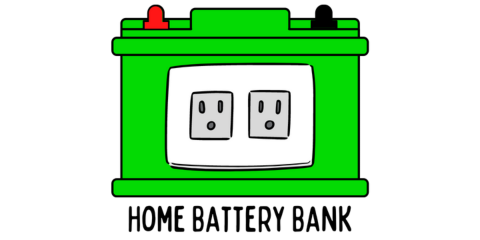Yikes! Your power just went out and your trusty generator is now running a bit rough and blowing out black smoke from the exhaust!
I’m not a pro but I’ve got 5 years of fixing up free and cheap small engines to flip them for resale, so I hope I can help.
Put simply:
A generator will blow out black smoke from the exhaust when it is running rich from the ideal (more fuel relative to the amount of air). A clogged air filter, poor fuel quality, a carburetor stuck on choke or a bad spark plug could all lead to this result. The fix is to introduce more air to the combustion chamber.
Why Does A Generator Blow Black Smoke Out the Exhaust
Black smoke is indicative of an engine running rich (too much fuel relative to the amount of air entering the combustion chamber). Lacking enough air, the engine has incomplete combustion and the black exhaust is the result of that along with popping in the exhaust from unburnt fuel spontaneously combusting when it meets with oxygen and high heat.| Cause | Reason | Fix |
|---|---|---|
| Clogged Air Filter | Restricts air and engine runs rich with incomplete combustion | Replace or clean air filter |
| Bad Spark plug | Carbon buildup, incorrect gap, age, or a bad ignition coil can cause spark too weak to combust completely | Replace, re-gap, or clean carbon from spark plug |
| Stale or Incorrect Fuel | Both can lead to incomplete combustion with different volatility properties from the manufacturer's specs | Drain fuel from tank and carburetor and replace |
| Choke is Stuck in "On" Position | Restricts air and engine runs rich with incomplete combustion | Reconnect choke lever or free choke butterfly valve with carburetor cleaner and work it free |
| High Temps or High Elevation (minimal black smoke) | Less oxygen in the air, runs rich with incomplete combustion | Deal with it in the short-term (eventually carbon build-up will ruin your spark plug, just replace); Consult with manufacturer to re-jet the carburetor if high elevation will be the permanent home of the generator |
| Bored Out Jets (Previous Owner, unlikely to happen) | More fuel enters the intake manifold for a richer mixture - incomplete combustion | Visually inspect to see if carburetor jets look altered, rebuild the carburetor with new jets |
Clogged Air Filter
This one is the easiest to remedy and should be the first on your list. If clogged, you’ll always run rich (not enough air for the amount of fuel entering the combustion chamber) and the air-fuel mix will burn incompletely which will lead to black smoke.
Most generators have an air filter assembly with 2 metal clasps. Simply undo them and remove the filter inside.
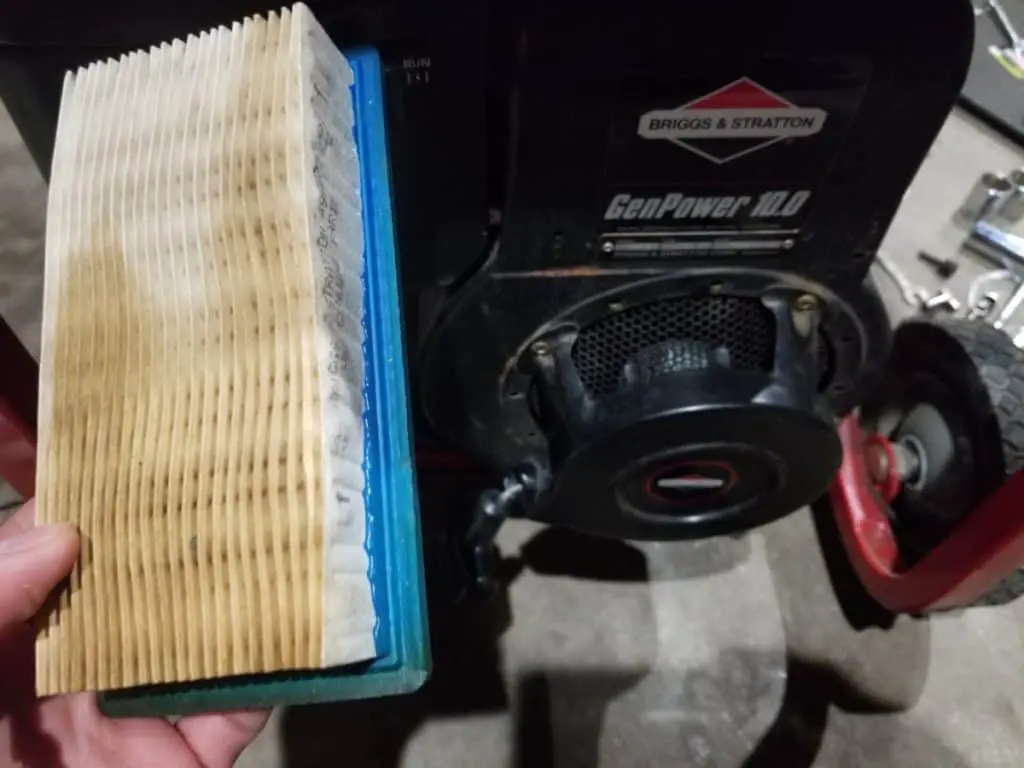
It started off white, so let that be your reference. If it is caked full of debris, discolored, or has oil on it that has collected dirt, then you should definitely look into replacing it.
With the air filter removed, clasp the cover back in place. Start your engine.
Does it run better? Your air filter is likely the problem and all you have to do is replace it.
Poor Fuel Quality
If you can’t remember when you last added fuel to your generator and you know that you didn’t treat it with fuel stabilizers like SeaFoam or Stabil, then you definitely need to drain the fuel from your gas tank and carburetor bowl.
The wrong fuel or fuel that has gone stale is not a good thing for optimal performance. Stale fuel has been oxidized and has lost its volatile “light ends” which are critical for proper combustion. The oxygen in the air also degrades the hundreds of additives that are in your gasoline that ensure optimal performance.
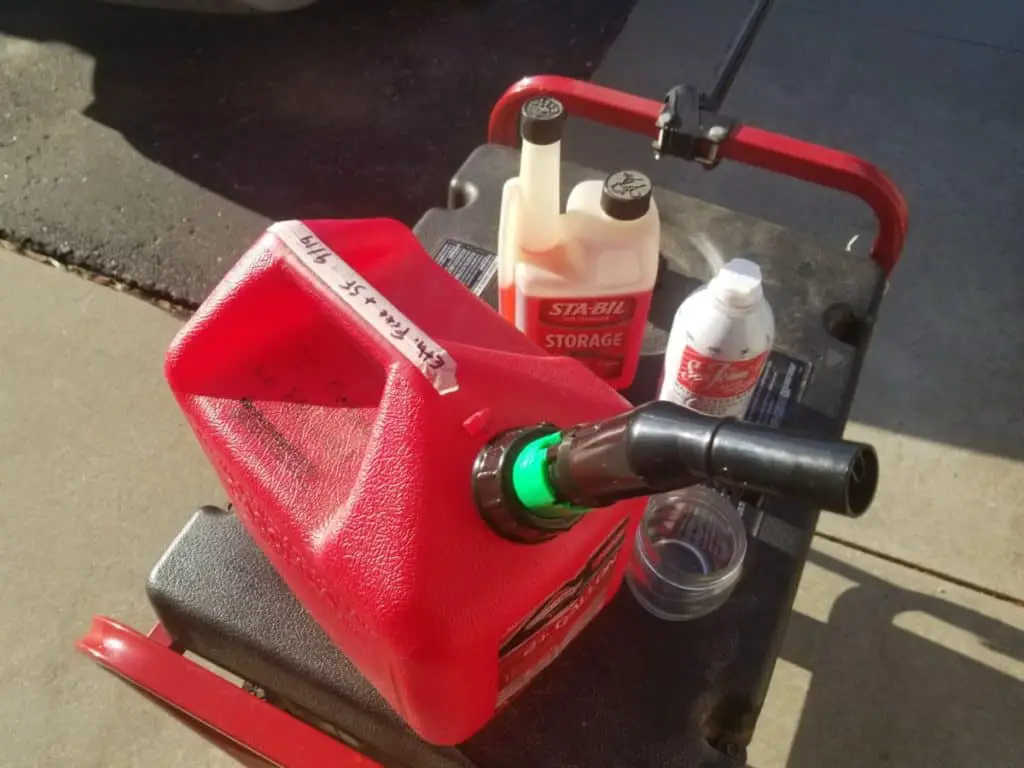
The wrong or stale fuel can lead to incomplete combustion, and this will lead to that pesky black smoke that you’re witnessing from your exhaust.
I recommend ethanol-free fuel with SeaFoam added to it (Amazon link). One ounce per gallon is all that’s needed. It will keep your fuel good for up to 2 years at least (from my tests) and will clean out the jets in your carburetor as well. You seriously can’t go wrong with this stuff!
Choke Closed (Stuck)
This can happen for two reasons. Both of them result in restricted airflow through the carburetor and the engine will have incomplete combustion and black exhaust from the rich mixture.
The first is that the choke lever that you use to slide the choke from “closed” to “run” has become detached or isn’t attached correctly. You generally have to remove the air filter assembly (only a few nuts or bolts holding it on) to visually see where the lapse in connection might be.
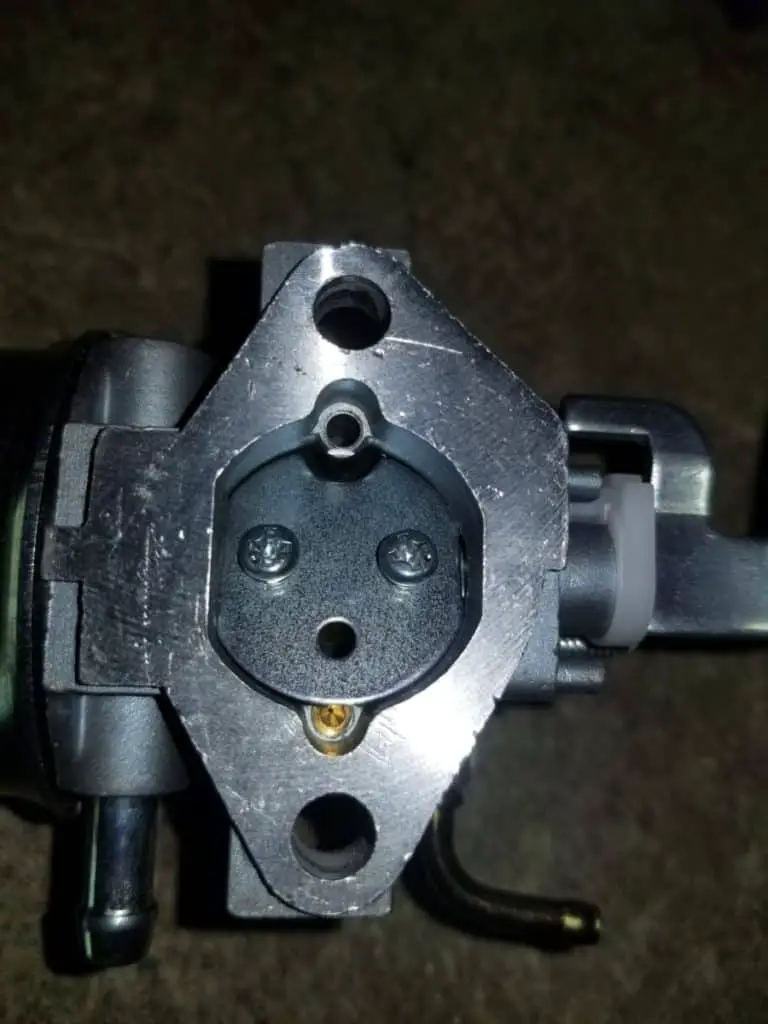
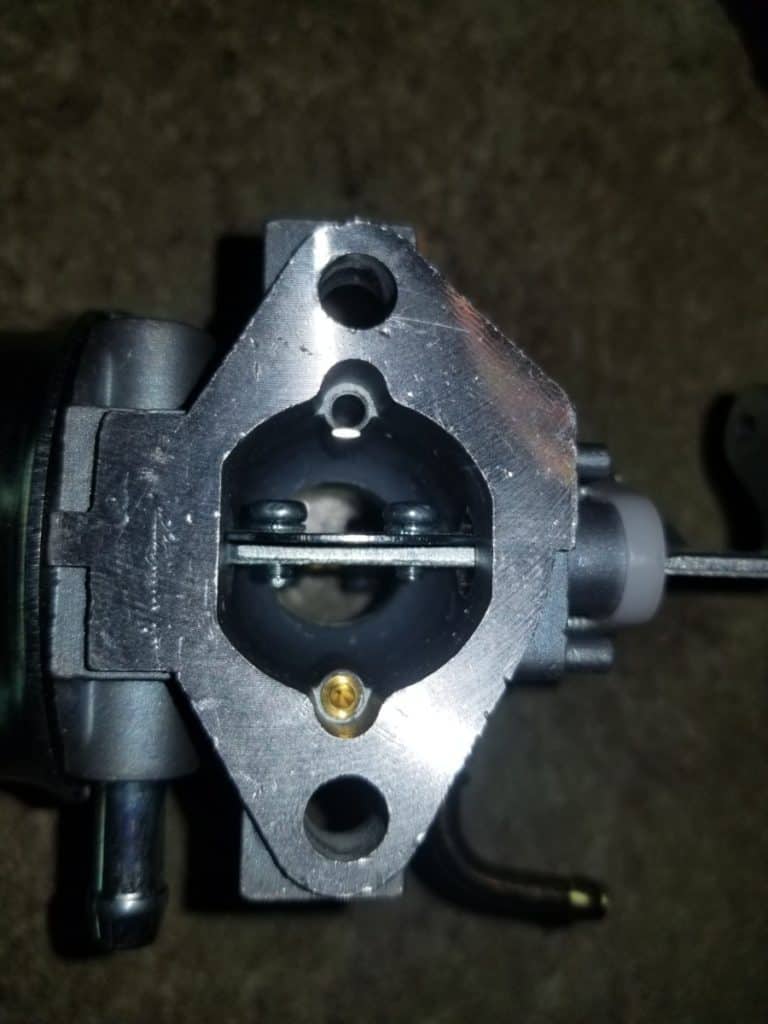
The second is that your butterfly valve has become stuck because of bad gas that has turned to varnish and the valve itself is physically glued in place. You’ll need some carburetor cleaner to loosen up that varnish. Spray liberally on the post where it connects with the body of the carburetor and work it free with your fingers or very gently if you use a pair of pliers.
You’ll likely need to do a complete cleaning of your carburetor if you experienced the second issue since your jets and carburetor bowl are probably gummed up as well. I have a complete step-by-step article here on how to do exactly that!
Weak Spark Plug (or Ignition Coil Going Bad)
If a spark plug isn’t giving off a strong enough spark or the correct timing of a spark, you’ll likely experience incomplete combustion and the result will be black smoke from the exhaust.
Remove the rubber boot from your spark plug by simply pulling it straight off. Some are on there good and I’ve had to use a pair of channel locks to gently squeeze them and remove them.
Once that’s done, you’ll likely need a deep-well socket (a tall one) to encompass the spark plug and the size will be dependent upon your particular model. Using the socket, unscrew the spark plug.
The spark plug should be relatively clean. If it looks like it’s covered in soot, then you’re definitely running lean. The soot is carbon deposits from the incomplete combustion inside the combustion chamber.
You can clean off the sparkplug the best you can by wiping it down with a rag or gently removing the carbon with a brass brush. Once that’s done, use a gapping tool like this one seen on Amazon to verify that your spark plug is set to the correct gap between the two nodes where the spark travels. You will have to consult your model’s manual for this.

When that’s done, reconnect the spark plug to the boot but don’t screw it in. When holding the rubber boot, place the metal threads of the spark plug in the engine block or valve cover (Usually reads: OHV) and gently pull the recoil starter cord. You should see sparks. If you do, remove the boot, screw in the spark plug and make it nicely snug without overtightening, and then reconnect the boot.
Start your engine again to see if the incorrect gap (if you had one) was the reason for your black smoke problem.
High Elevation, High temperatures (Generally not very smokey)
This one is usually temporary for someone if they travel with their generator to a much higher elevation than they are used to. Luckily, the black smoke isn’t something that should alarm you too much since it shouldn’t be much (as long as everything is tuned up normally and the carburetor is clean).
High elevations and hot temperatures both reduce the number of oxygen molecules in a given quantity of air. This will necessarily make your engine run richer which will lead to incomplete combustion and black exhaust. Again though, it shouldn’t be much when compared to other issues.
If a higher elevation is your new home, you will want to consult with your generator’s manufacturer and see if they offer different jets (smaller holes to reduce the fuel) that will be better suited for higher elevation.
If you are there temporarily, it is just something you’ll have to tolerate for a while. You’ll lose a little bit of power (capacity) but the power shouldn’t be dirty (quality) for your devices. You’ll likely end up with a spark plug with a reduced lifespan from the carbon buildup. That’s why I always keep 2 extras spark plugs on hand since they are so cheap to begin with.
Carburetor Alterations by Previous Owner (Bored-Out Jets)
You’re more likely to find this happen with a used snowblower, but it isn’t impossible for it to have happened to a generator. If a previous owner was looking to soup-up his engine by making some alterations to the carburetor, he might have bored out the jets to allow more gas to pass through this can lead to a rich mixture which will result in black exhaust from incomplete combustion.
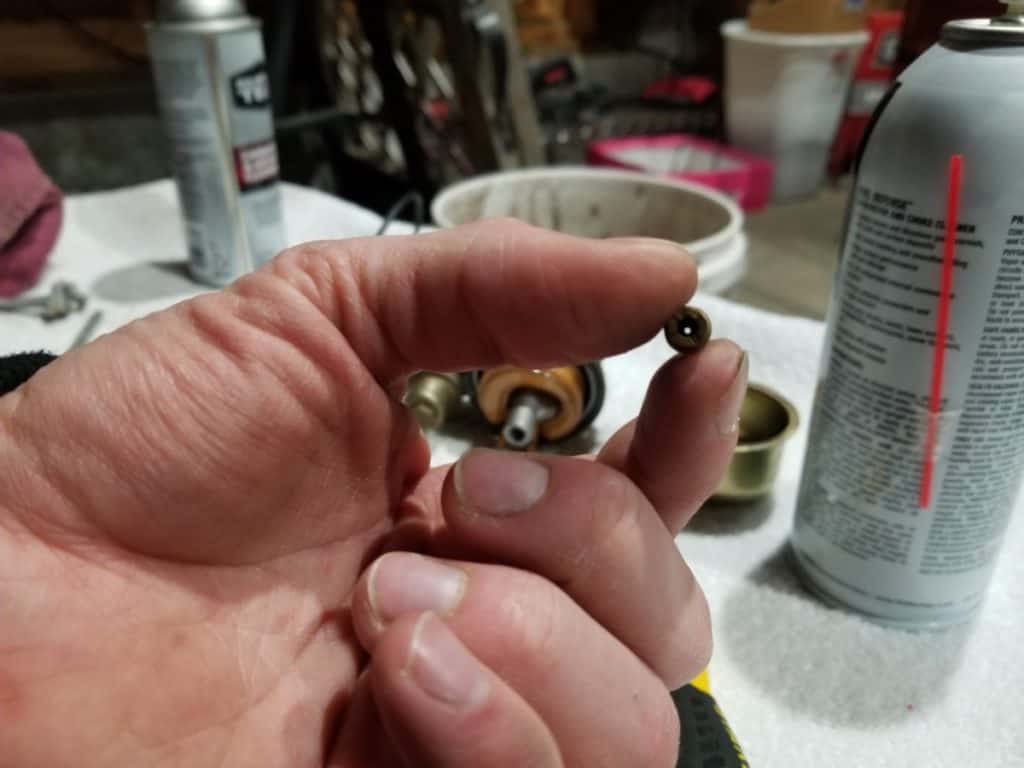
Once this is done, it cannot be undone. You can only replace the jets or the whole carburetor, which shouldn’t cost too much money for an aftermarket unit.
Operating Generator in an Enclosed Space
This may happen if you construct a makeshift rain shelter, or even if you buy one that is designed for the specific purpose of protecting your generator from the elements while running.
The restricted airflow will lead to higher temps (lowers oxygen availability) and more carbon monoxide levels around the generator which also means less oxygen available for proper combustion in your engine.
You can quickly figure out if this is the case by removing the generator temporarily from the enclosed space. If it stops blowing black smoke, you’ve found your problem.
If your makeshift rain structure was indeed the culprit, they make a fantastic universal rain tent seen on Amazon for your generator that will keep the elements off of it while you’re operating it. Just make sure that you install it so that the hot exhaust can expel from the generator and isn’t trapped inside the tent.
Let Me Know How it Goes!
If this helped you out, I’d love to hear about it, and if I’m missing something I’d love to hear about that too. I’m in this to learn and to help others learn as well. Good luck with your power outage!
contact.homebatterybank@gmail.com
